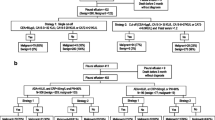Abstract
Purpose
The usefulness of a panel of tumour markers and clinical-radiological criteria for diagnosing malignant pleural effusion (MPE) is not clearly stated. Our purpose was to assess the performance of those parameters in the diagnosis of MPE.
Methods
Consecutive patients with exudative PE were enrolled and divided into two groups: MPE and non-MPE. Logistic regression analysis was used to estimate the probability of MPE. Four prognostic models were considered: (1) clinical-radiological variables; (2) analytical variables; (3) combination of clinical and analytical variables; and (4) simpler model removing some analytical variables. Calibration and discrimination (receiver operating characteristics curves and AUC) were performed.
Results
A total of 491 pleural exudates were included: tuberculous (n = 72), malignant (n = 211), parapneumonic (n = 115), empyemas (n = 32), or miscellaneous (n = 61). The AUC obtained with Model 1 (absence of chest pain and fever and radiological images compatible with malignancy), Model 2 (CEA, NSE, CYFRA 21-1, and TPS), Model 3 (sum of the variables of models 1 and 2), and Model 4 (the variables of model 1 plus CEA) were 0.918, 0.832, 0.952 (all with a P < 0.05), and 0.939 (P < 0.01 compared to models 1 and 2), respectively. The correct classification rate for Models 1, 2, 3, and 4, was 87.2, 79.5, 88.4, and 87.6 %, respectively.
Conclusions
All models analysed had a good diagnostic yield for MPE, being greater in those that combined radiological and analytical criteria. Although Model 3 obtained a higher yield, the simplest model (Model 4) is very attractive due to its simplicity of use in daily practice.





Similar content being viewed by others
References
Light RW (2002) Clinical practice: pleural effusion. N Engl J Med 346:1971–1977
Maskell NA, Butland RJA (2003) BTS guidelines for the investigation of a unilateral pleural effusion in adults. Thorax 58(suppl 11):ii8–ii17
Sahn SA (1989) State of the art: the pleura. Am Rev Respir Dis 138:188–234
San José ME, Álvarez D, Valdés L et al (1997) Utility of tumour markers in the diagnosis of neoplastic pleural effusion. Clin Chim Acta 265:193–205
Porcel JM, Vives M, Esquerda A et al (2004) Use of a panel of tumor markers (carcinoembryonic antigen, cancer antigen 125, carbohydrate antigen 15-3, and cytokeratin 19 fragments) in pleural fluid for the differential diagnosis of benign and malignant effusions. Chest 126:1757–1763
Shi HZ, Liang QL, Jiang J et al (2008) Diagnostic value of carcinoembryonic antigen in malignant pleural effusion: a meta-analysis. Respirology 13:518–527
Liang QL, Shi HZ, Qin XJ et al (2008) Diagnostic accuracy of tumour markers for malignant pleural effusion: a meta-analysis. Thorax 63:35–41
Huang WW, Tsao SM, Lai CL et al (2010) Diagnostic value of Her-2/neu, cyfra 21-1, and carcinoembryonic antigen levels in malignant pleural effusions of lung adenocarcinoma. Pathology 42:224–228
Hackbarth JS, Murata K, Reilly WM et al (2010) Performance of CEA and CA19-9 in identifying pleural effusions caused by specific malignancies. Clin Biochem 43:1051–1055
Hansen M, Faurschou P, Clementsen P (1998) Medical thoracoscopy, results and complications in 146 patients: a retrospective study. Respir Med 92:228–232
Ferrer J, Roldan J, Teixidor J et al (2005) Predictors of pleural malignancy in patients with pleural effusion undergoing thoracoscopy. Chest 127:1017–1022
Sahn SA (1987) Malignant pleural effusions. Semin Respir Med 9:43–53
Villena-Garrido V, Ferrer-Sancho J, Hernández-Blasco L et al (2006) Diagnóstico y tratamiento del derrame pleural. Arch Bronconeumol 42:349–372
Boutin C, Astoul P (1998) Diagnostic thoracoscopy. Clin Chest Med 19:295–309
Brezger A, Kneib T, Lang S (2005) Bayes X: analyzing Bayesian structural additive regression models. J Stat Softw 14(11):1–22
Eilers PHC, Marx BD (1996) Flexible smoothing using B-splines and penalties (with comments and rejoinder). Stat Sci 11:89–121
Harrell FE Jr (2001) Regression modelling strategies: with applications to linear models, logistic regression, and survival analysis. Springer, New York
R Development Core Team (2012). R: a language and environment for statistical computing. R Foundation for Statistical Computing, Vienna, Austria. ISBN 3-900051-07-0. http://www.R-project.org. Accessed 17 May 2013
Ferrer JS, Munoz XG, Orriols RM et al (1996) Evolution of idiopathic pleural effusion. A prospective, long-term follow-up study. Chest 109:1508–1513
Bielsa S, Esquerda A, Salud A et al (2009) High levels of tumor markers in pleural fluid correlate with poor survival in patients with adenocarcinomatous or squamous malignant effusions. Eur J Intern Med 20:383–386
Gaspar MJ, de Miguel J, Garcia Diaz JD et al (2008) Clinical utility of a combination of tumour markers in the diagnosis of malignant pleural effusions. Anticancer Res 28:2947–2952
Barak V, Goike H, Panaretakis KW et al (2004) Clinical utility of cytokeratins as tumor markers. Clin Biochem 37:529–540
Roberts ME, Neville E, Berrisford RG, Antunes G, Ali NJ (2010) Management of a malignant pleural effusion: British Thoracic Society pleural disease guideline 2010. Thorax 65(Suppl 2):ii32–ii40
MacEachern P, Tremblay A (2011) Pleural controversy: pleurodesis versus indwelling pleural catheters for malignant effusions. Respirology 16:747–754
Conflict of Interest
None.
Author information
Authors and Affiliations
Corresponding author
Electronic supplementary material
Below is the link to the electronic supplementary material.
Rights and permissions
About this article
Cite this article
Valdés, L., San-José, E., Ferreiro, L. et al. Combining Clinical and Analytical Parameters Improves Prediction of Malignant Pleural Effusion. Lung 191, 633–643 (2013). https://doi.org/10.1007/s00408-013-9512-2
Received:
Accepted:
Published:
Issue Date:
DOI: https://doi.org/10.1007/s00408-013-9512-2




